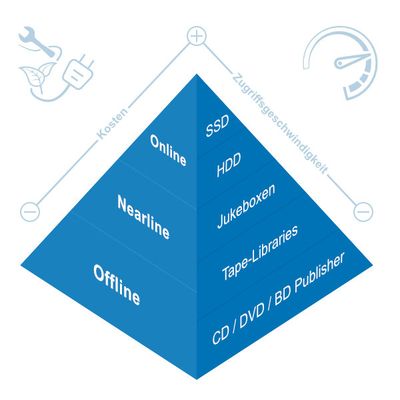Digital information is called the raw material of the 21st century. Depending on the industry and the type of data, it must be stored for at least 10, but some for 30 years and more. However, this data is generally not relevant to day-to-day business and is therefore hardly or not at all used.
For this form of archiving, the lifetime of the data carriers and the total cost of the storage solution is more important than the access speed. Data that is hardly ever used does not have to be stored on ever rotating hard disks that permanently consume electricity and generate heat, which in turn has to be expensively cooled down by air conditioning systems in the data centers. In addition, hard disk storage must be replaced every 3-5 years, as they wear out at some point during continuous use.
Data is often also stored on tape, which makes more sense in terms of energy consumption, but is risky in many respects due to the technical properties for long-term archiving, because tape is subject to physical wear. The magnetized layers of a tape, which lie very close together, demagnetize the data carrier, which can be counteracted by regular rewinding, but this in turn stretches the tapes, which also applies to acceleration and stopping, e.g. when individual smaller files have to be read from the tape in LTSF format. Another negative aspect is the limited compatibility of the technology itself, because the tapes can only be read with the software with which they were written, and even with the drives, the readability of the written tapes is limited to a few generations of deviation.
The recommendation therefore clearly goes to optical data carriers, which do not deserve the term COLD simply because of their low energy consumption and thus low heat generation. The compatibility is also unbeatable, because all current drives can still read the CDs of the first hour. Due to the long durability of the archive media (up to 100 years), the labor-intensive and usually expensive migration is no longer necessary, which with the alternatives mentioned above is due every 5-10 years at the latest, when compatible hardware is no longer available or software manufacturers disappear from the market. The Blu-ray media described in the libraries according to ISO standard can be read in any standard PC drive.
The scalability of the systems is also unparalleled, because whether the data should be available nearline in a library, as in the Facebook project, where several petabytes of video data are stored, or offline, as in many university research institutions or in production, for archiving process data, ultimately depends on the area of application and the budget. Even for faster access to data, the StorEasy WormAppliance provides hybrid systems that combine the advantages of the technologies with a unique security architecture.
